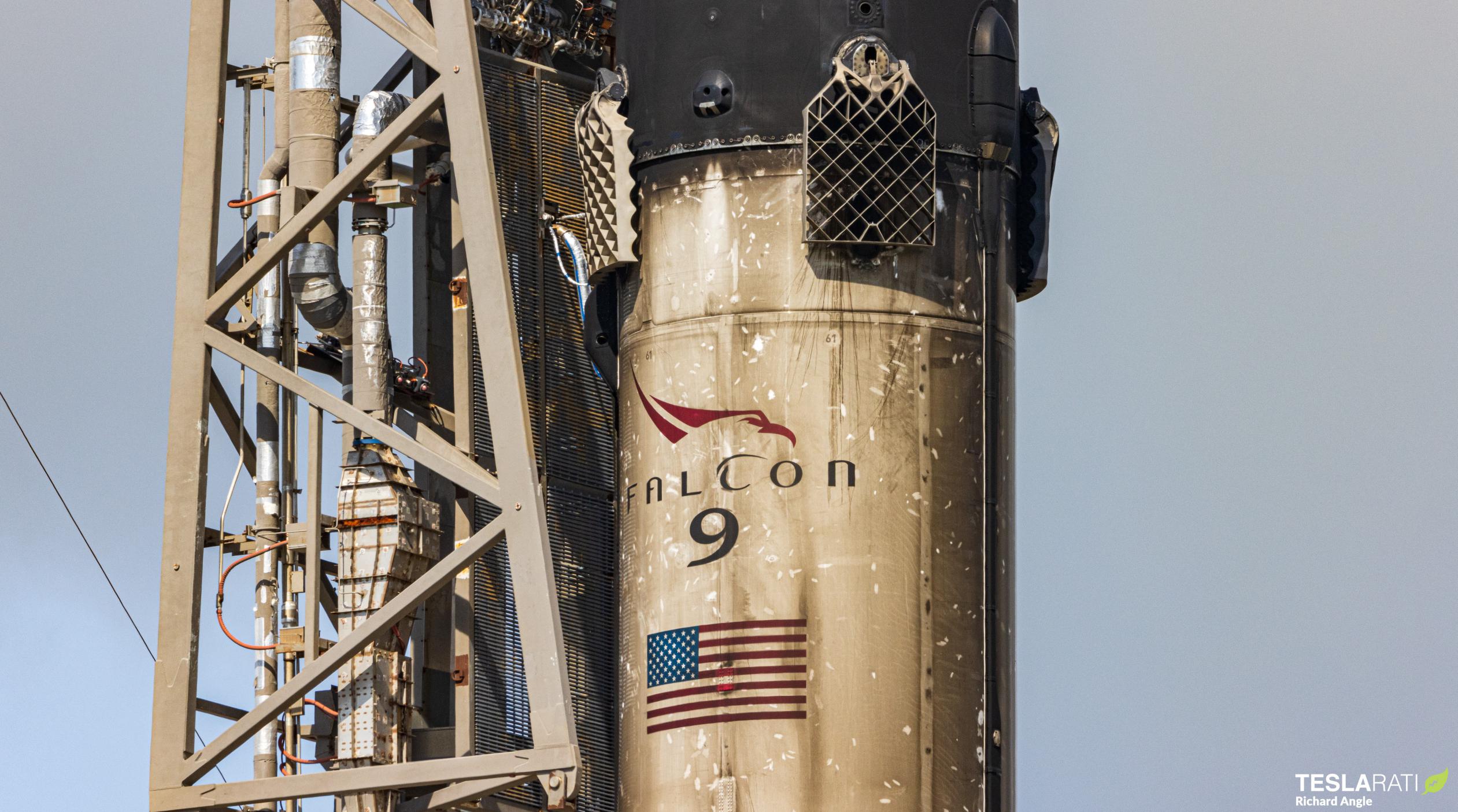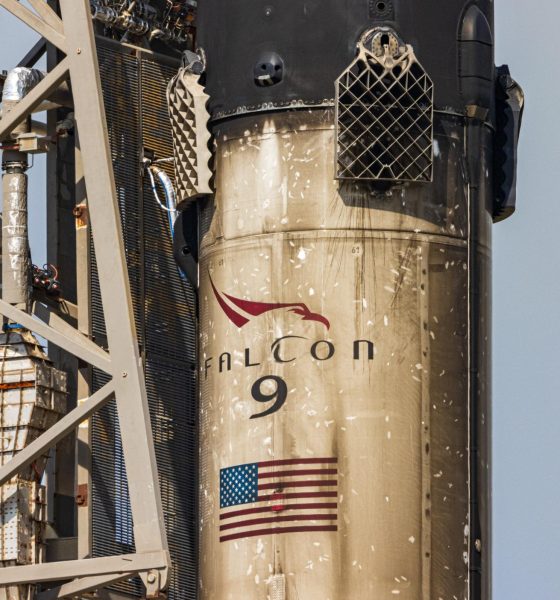

News
SpaceX indefinitely delays second Falcon 9 launch in two weeks
For the second time in less than two weeks, SpaceX has indefinitely delayed a Falcon 9 launch after discovering apparent issues with the rocket less than a day before liftoff.
Japanese startup ispace’s misfortune also marks the eighth time in less than two months that SpaceX has delayed or aborted a Falcon 9 launch for unspecified technical reasons less than 24 hours before liftoff. The streak of delays is unusual after 12 months of record-breaking execution, over the course of which SpaceX has successfully completed 60 orbital launches with just a handful of last-minute technical delays.
The update that's rolling out to the fleet makes full use of the front and rear steering travel to minimize turning circle. In this case a reduction of 1.6 feet just over the air— Wes (@wmorrill3) April 16, 2024
The number of last-day delays and Falcon 9 launch aborts has abruptly skyrocketed in recent months, possibly indicating that a single problem or change is at least partially responsible for the trend. The streak began in early October and has continued through the end of November, resulting in eight delays in two months, with impacts ranging from minutes to days or even weeks. In all but one instance, SpaceX’s only explanation was a need for more time for “data review” or “checkouts” of the rocket, its payload, or both.
SpaceX consistently announces launch delays on Twitter, making it possible to collate when the company has stated it was “standing down” from a launch attempt or “now targeting” a later launch date for technical reasons. In the 18+ months between March 2021 and October 2022, SpaceX announced only three technical delays after publicly scheduling a launch (one last-second abort and two minor “additional checkouts” delays). Adding to the oddity, SpaceX reported at least 15 similar delays between January 2020 and March 2021.
A decrease in the frequency of technical issues is a generally expected outcome of a competent organization gaining experience with the operation of a complex, new system (like a launch vehicle). By all appearances, that’s the pattern SpaceX was following: a drastic drop in the number of technical launch aborts even as the pace of Falcon 9 launches soared to new heights. But within the last two months, the frequency of technical delays has skyrocketed from close to zero to higher than any point in recent SpaceX history.
Without context, it’s impossible to say if there is an invisible thread connecting the recent string of delays. There are many possible explanations, including workforce fatigue, management changes, policy changes, and factory issues. It’s even possible that the seemingly sudden onset was caused by an intentional change of risk posture: for example, increasing sensitivity to off-nominal signals that had been observed before but were discounted enough to avoid launch delays.
As part of its effort to continually improve existing systems and processes, SpaceX could have changed things too much or removed one too many steps. While unlikely, it’s also possible that the recent uptick in delays is merely a coincidence. Regardless, if the trend continues, it will be difficult for SpaceX to increase its launch cadence any further – particularly toward CEO Elon Musk’s stated goal of 100 launches in 2023. Delays also increase launch costs and disrupt customer plans, incentivizing a return to smoother operations as quickly as possible.
Most concerning is a recent pair of unrelated launches that have become indefinitely delayed. Starlink 2-4, first scheduled to launch on November 18th, has yet to receive a new launch date after SpaceX apparently discovered problems after a Falcon 9 static fire test on November 17th. Less than two weeks later, SpaceX has indefinitely delayed a second Falcon 9 launch – Japanese startup ispace’s first Moon landing attempt – “after further inspections of the launch vehicle and data review.”
Ultimately, launch delays are a fundamental part of spaceflight, and it’s better to keep a rocket on the ground when there is any uncertainty about its readiness for flight. Nonetheless, big changes in the frequency of delays are still noteworthy, especially when SpaceX itself does not typically explain the cause of delays for non-NASA missions.
SpaceX has several more Falcon 9 launches firmly scheduled in December. It remains to be seen how exactly the indefinite delays of Starlink 2-4 and HAKUTO-R will impact those upcoming launches. Starlink 4-37, for example, was scheduled to launch from the same pad as HAKUTO-R as early as December 6th, but that date will slip for every day HAKUTO-R is delayed. A SpaceX ship tasked with recovering HAKUTO-R’s Falcon 9 fairing appears to be heading back to port, indicating a delay of at least two or three days.

Elon Musk
Elon Musk’s X will start using a Tesla-like software update strategy
The initiative seems designed to accelerate updates to the social media platform, while maintaining maximum transparency.

Elon Musk’s social media platform X will adopt a Tesla-esque approach to software updates for its algorithm.
The initiative seems designed to accelerate updates to the social media platform, while maintaining maximum transparency.
X’s updates to its updates
As per Musk in a post on X, the social media company will be making a new algorithm to determine what organic and advertising posts are recommended to users. These updates would then be repeated every four weeks.
“We will make the new 𝕏 algorithm, including all code used to determine what organic and advertising posts are recommended to users, open source in 7 days. This will be repeated every 4 weeks, with comprehensive developer notes, to help you understand what changed,” Musk wrote in his post.
The initiative somewhat mirrors Tesla’s over-the-air update model, where vehicle software is regularly refined and pushed to users with detailed release notes. This should allow users to better understand the details of X’s every update and foster a healthy feedback loop for the social media platform.
xAI and X
X, formerly Twitter, has been acquired by Elon Musk’s artificial intelligence startup, xAI last year. Since then, xAI has seen a rapid rise in valuation. Following the company’s the company’s upsized $20 billion Series E funding round, estimates now suggest that xAI is worth tens about $230 to $235 billion. That’s several times larger than Tesla when Elon Musk received his controversial 2018 CEO Performance Award.
As per xAI, the Series E funding round attracted a diverse group of investors, including Valor Equity Partners, Stepstone Group, Fidelity Management & Research Company, Qatar Investment Authority, MGX, and Baron Capital Group, among others. Strategic partners NVIDIA and Cisco Investments also continued support for building the world’s largest GPU clusters.
News
Tesla FSD Supervised wins MotorTrend’s Best Driver Assistance Award
The decision marks a notable reversal for the publication from prior years, with judges citing major real-world improvements that pushed Tesla’s latest FSD software ahead of every competing ADAS system.

Tesla’s Full Self-Driving (Supervised) system has been named the best driver-assistance technology on the market, earning top honors at the 2026 MotorTrend Best Tech Awards.
The decision marks a notable reversal for the publication from prior years, with judges citing major real-world improvements that pushed Tesla’s latest FSD software ahead of every competing ADAS system. And it wasn’t even close.
MotorTrend reverses course
MotorTrend awarded Tesla FSD (Supervised) its 2026 Best Tech Driver Assistance title after extensive testing of the latest v14 software. The publication acknowledged that it had previously criticized earlier versions of FSD for erratic behavior and near-miss incidents, ultimately favoring rivals such as GM’s Super Cruise in earlier evaluations.
According to MotorTrend, the newest iteration of FSD resolved many of those shortcomings. Testers said v14 showed far smoother behavior in complex urban scenarios, including unprotected left turns, traffic circles, emergency vehicles, and dense city streets. While the system still requires constant driver supervision, judges concluded that no other advanced driver-assistance system currently matches its breadth of capability.
Unlike rival systems that rely on combinations of cameras, radar, lidar, and mapped highways, Tesla’s FSD operates using a camera-only approach and is capable of driving on city streets, rural roads, and freeways. MotorTrend stated that pure utility, the ability to handle nearly all road types, ultimately separated FSD from competitors like Ford BlueCruise, GM Super Cruise, and BMW’s Highway Assistant.
High cost and high capability
MotorTrend also addressed FSD’s pricing, which remains significantly higher than rival systems. Tesla currently charges $8,000 for a one-time purchase or $99 per month for a subscription, compared with far lower upfront and subscription costs from other automakers. The publication noted that the premium is justified given FSD’s unmatched scope and continuous software evolution.
Safety remained a central focus of the evaluation. While testers reported collision-free operation over thousands of miles, they noted ongoing concerns around FSD’s configurable driving modes, including options that allow aggressive driving and speeds beyond posted limits. MotorTrend emphasized that, like all Level 2 systems, FSD still depends on a fully attentive human driver at all times.
Despite those caveats, the publication concluded that Tesla’s rapid software progress fundamentally reshaped the competitive landscape. For drivers seeking the most capable hands-on driver-assistance system available today, MotorTrend concluded Tesla FSD (Supervised) now stands alone at the top.
News
Elon Musk’s Grokipedia surges to 5.6M articles, almost 79% of English Wikipedia
The explosive growth marks a major milestone for the AI-powered online encyclopedia, which was launched by Elon Musk’s xAI just months ago.

Elon Musk’s Grokipedia has grown to an impressive 5,615,201 articles as of today, closing in on 79% of the English Wikipedia’s current total of 7,119,376 articles.
The explosive growth marks a major milestone for the AI-powered online encyclopedia, which was launched by Elon Musk’s xAI just months ago. Needless to say, it would only be a matter of time before Grokipedia exceeds English Wikipedia in sheer volume.
Grokipedia’s rapid growth
xAI’s vision for Grokipedia emphasizes neutrality, while Grok’s reasoning capabilities allow for fast drafting and fact-checking. When Elon Musk announced the initiative in late September 2025, he noted that Grokipedia would be an improvement to Wikipedia because it would be designed to avoid bias.
At the time, Musk noted that Grokipedia “is a necessary step towards the xAI goal of understanding the Universe.”
Grokipedia was launched in late October, and while xAI was careful to list it only as Version 0.1 at the time, the online encyclopedia immediately earned praise. Wikipedia co-founder Larry Sanger highlighted the project’s innovative approach, noting how it leverages AI to fill knowledge gaps and enable rapid updates. Netizens also observed how Grokipedia tends to present articles in a more objective manner compared to Wikipedia, which is edited by humans.
Elon Musk’s ambitious plans
With 5,615,201 total articles, Grokipedia has now grown to almost 79% of English Wikipedia’s article base. This is incredibly quick, though Grokipedia remains text-only for now. xAI, for its part, has now updated the online encyclopedia’s iteration to v0.2.
Elon Musk has shared bold ideas for Grokipedia, including sending a record of the entire knowledge base to space as part of xAI’s mission to preserve and expand human understanding. At some point, Musk stated that Grokipedia will be renamed to Encyclopedia Galactica, and it will be sent to the cosmos.
“When Grokipedia is good enough (long way to go), we will change the name to Encyclopedia Galactica. It will be an open source distillation of all knowledge, including audio, images and video. Join xAI to help build the sci-fi version of the Library of Alexandria!” Musk wrote, adding in a later post that “Copies will be etched in stone and sent to the Moon, Mars and beyond. This time, it will not be lost.”








